Achieving business goals can be successful by understanding underlying concepts and adopting a goal-setting framework that suits your business needs. There are several goal-setting methodologies in the industry and choosing the one that fits your requirements can facilitate optimal results.
NCT vs OKR, wondering which framework works better? Can the goal-setting methodologies be combined? In this article, we will compare NCT (Narrative, Commitment, Tasks) and OKR (Objectives and Key Results) goal-setting frameworks. Read on to compare the similarities and find out how you could combine the methodologies.
Drive long-term performance 📈
Track and measure outcome-centric goals. Create your roadmap to success with goal visualization in dedicated software.
What is NCT (Narrative, Commitment, Tasks)?
The NCT framework consists of three components – Narratives, Commitments, and Tasks. It was designed to empower teams by providing them with a system to clarify the elements of ”what, why, and how” to get work done.
1. Narratives – “Why”
- Focuses on the purpose
- Helps identify why an initiative is given priority
- Clarifies how initiatives fit into broader company strategy
A Narrative describes what a team wants to achieve, the desired outcomes, and why it is important. When a narrative is created effectively it can ensure that teams set lofty goals that are aligned and have a strategic context by providing a clear picture about what matters and why it is important.
2. Commitments – “What”
- Focuses on objective goals
- Captures the progress made toward achieving the narrative
Establishing actionable commitments can help to track and measure goals objectively every quarter. Ideally, creating three to five measurable commitments can help teams to track the progress made toward achieving their narratives.
3. Tasks – “How”
- Focuses on what needs to be done
- Helps determine how a goal can be achieved
Tasks describe what work needs to be done to deliver the narrative and meet commitments. It can be an evolving list of initiatives that illustrate how each team plans to meet its commitments. Keep in mind that completing a task does not necessarily mean success unless it archives the narrative and meets the defined commitments.
Ready to level up your goal setting process?
What are OKRs?
OKR is a goal-setting framework that focuses on setting ambitious and measurable goals. It consists of Objectives and Key Results that help to prioritize improvement areas by tracking goals and measuring progress. Aligning the team’s goals and company strategy, OKRs provide a structured method to set goals, improve collaboration, and gain an overview of overall progress and team initiatives.
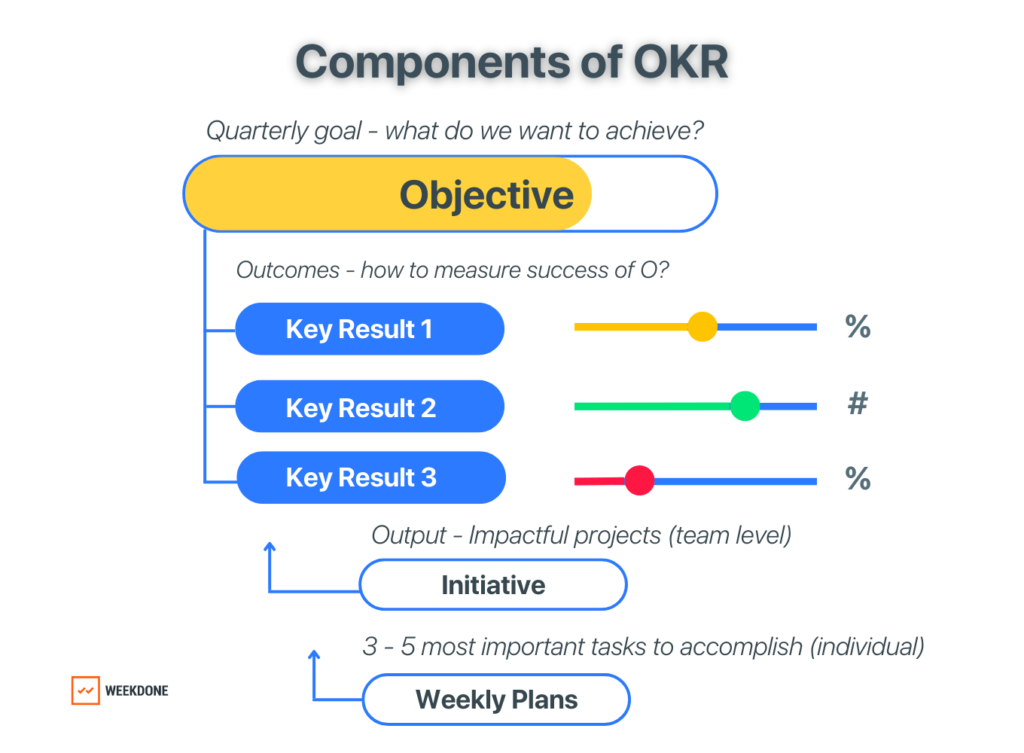
What are Objectives?
- Focuses on areas that need improvement
- Includes aspiring and qualitative goals
- Actionable goals are created to be achievable in a quarter
Objectives are created on a company and team level. A Company Objective is typically a high-level improvement area that can involve the contribution of several teams. The best practice that leadership teams should follow before finalizing Objectives is to share defined company goals and get feedback from the teams, and clarify their expectations. The Company Objective should be broad yet specific – to provide clear direction and enable teams to derive their OKRs.
Once the Company Objectives are defined they can be translated into the Team OKRs. This bottom-up alignment and OKR hierarchy ensure that the goals of different teams are aligned with the overall company strategy.
2. What are Key Results?
- Focuses on outcomes that need to be set to achieve the Objectives
- Includes quantitative metrics that are measurable outcomes not outputs
- Actionable and time-bound
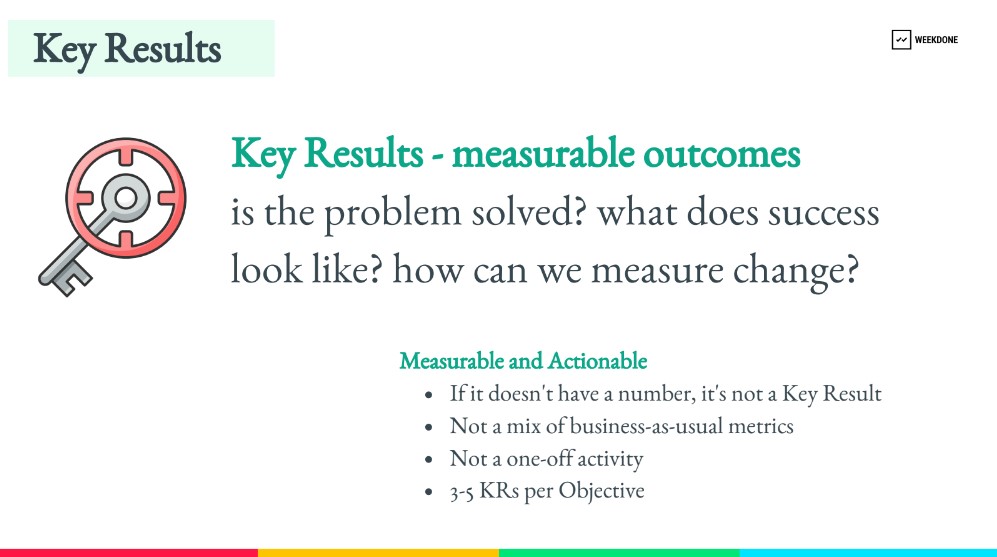
Key results determine the outcomes that need to be measured and how high-priority goals can be accomplished. Ideally, at least two to five Key Results can be set for every objective. Setting quantifiable key results with metrics provides an actionable approach to measuring and assessing the progress made toward achieving goals.
💡 Keep in mind that Key Results (KRs) are outcomes, unlike company and team KPIs which are performance measurements.
3. What are Weekly Plans or Check-ins?
Weekly plans or Weekly Check-ins include three components – Plans, Progress, and Problems (PPPs). Utilizing this task management method of weekly planning and status reporting has proven to be a good approach to ensure successful OKR implementation.
- Progress – Records the accomplishments, completed and closed tasks for the current reporting period
- Plans – The objectives and goals planned for the upcoming reporting period
- Problems – Includes the challenges and roadblocks that require help from other team members to be completed
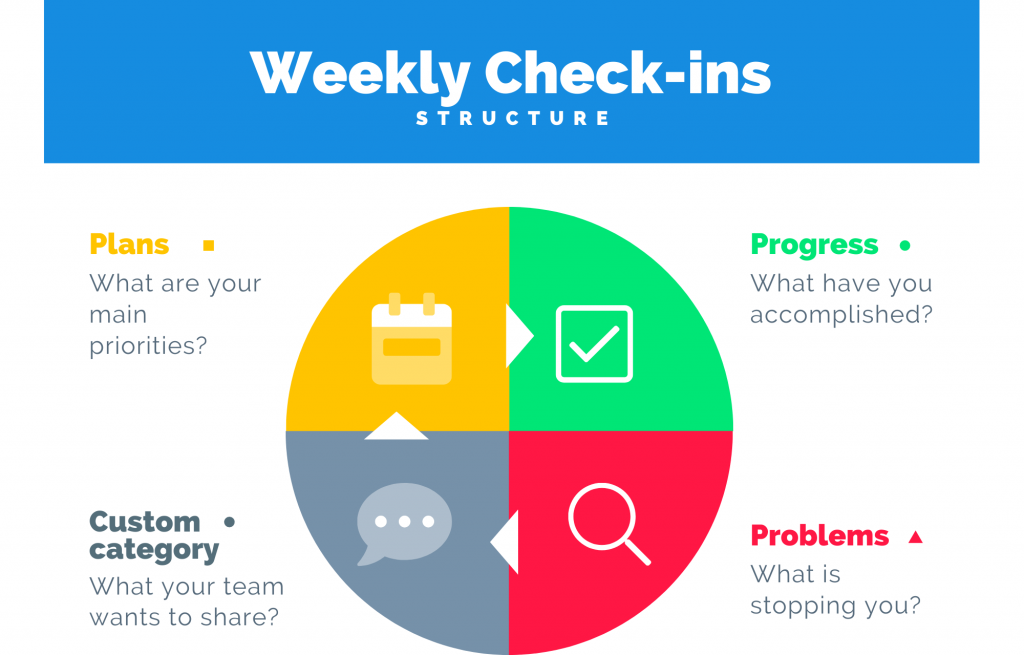
4. What are Initiatives?
- An output or task that takes a few weeks to a whole quarter to complete
- It includes projects or tasks that drive the Objective forward by achieving the outcomes defined in the Key Results
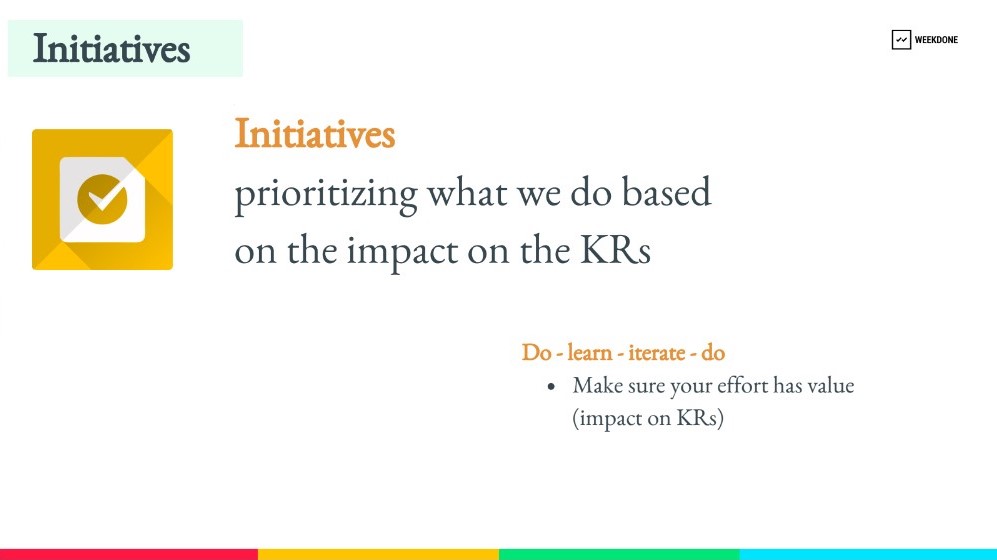
Creating an action plan and identifying initiatives are required to ensure your objectives are achieved. A common mistake is to add tasks and milestones in Key Results. Instead, adding output-driven action plans as initiatives can help identify tasks that need to be accomplished to achieve the goals.
Initiatives could be independent and not connected to any OKR or they could be specific initiatives linked to a particular OKR. The list of Initiatives can evolve in the quarter based on finding new ways to drive the KRs forward.
Drive long-term performance 📈
Track and measure outcome-centric goals. Create your roadmap to success with goal visualization in dedicated software.
OKR Planning and Implementation
When planning OKRs, it is important to create a link between the teams’ initiatives and the company’s vision, mission, and strategy. Here’s a simple step-by-step guide that could be useful when creating OKRs:
- Step 1: Identify the Company Objectives and Strategy for the quarter (Leaders)
- Step 2: Translate Company Objectives into Team OKRs (Team Managers and Team Members)
- Step 3: Create an execution plan for Team OKRs
- Step 4: Initiate a tracking system to measure and assess OKRs
- Step 5: Share and exchange plans, progress updates, and learnings
- Step 6: Provide feedback and recognize achievements
- Step 7: Create a definite and regular check-in process to maintain focus on goals – whether through weekly check-ins, monthly or quarterly reviews, or quarterly retrospectives
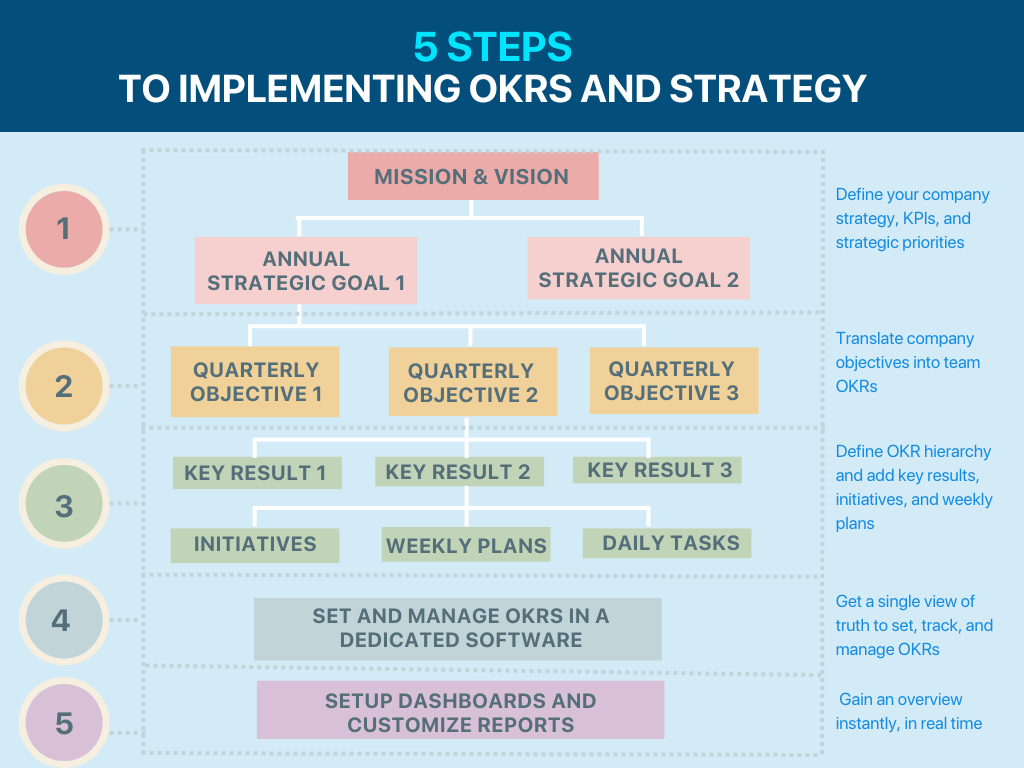
👉 Learn more about OKRs and see how the framework can work your business model and help your translate strategy to action.
Ready to level up your goal setting process?
NCT vs OKR Comparison
Taking into account both frameworks NCT and OKRs have similar structures. The best approach is to choose one framework or combine them to make it relevant to your business context. Let us look at both frameworks to understand some of the similarities.
| OKR | NCT | |
|---|---|---|
| Goal Definition | Defined as Objectives Aligned with company goals | Defined as Narratives Focuses on why a goal is important |
| Measuring and Tracking | Measured and tracked using Key Results and KPIs | Measured and tracked using Commitments |
| Execution | Execution of goals is defined by Initiatives and Weekly Plans | Execution is defined by Tasks |
| Implementation | OKR implementation is typically done in a quarterly cycle | Implemented quarterly |
| Goal Alignment | OKR Hierarchy provides a link that can showcase how team OKRs are aligned with company goals and strategy | The Narrative is linked to the company’s strategy |
| Maturity Level | Implementation requires in-depth knowledge of OKR concepts | Implementation requires a basic understanding of the goal-setting process |
NCT and OKR Examples
Company Objective: Drive revenue by improving customer retention
- Product team Objective: Improve in-product onboarding messaging
- Marketing team Objective: Focus on increasing the engagement rate of enterprise Marketing Qualified Leads (MQLs) for high-value customers
- Customer Success team Objective: Revamp and improve relationship-building initiatives with all customers
Marketing Team Objective: Grow the MQL pipeline and increase conversion rate using different promotional channels
Key Results
- KR1: Increase MQLs from email marketing campaigns from 50 to 100
- KR2: Increase MQLs from the AdWords campaign from 80 to 120
- KR3: Increase MQLs from organic search from 50 to 70
| Narrative Launch a new product version that includes the latest technology capabilities to attract a larger user base and improve performance for current users Commitments – Launch the beta version by the end of the quarter – Increase user base from 10k to 15k – Increase trial to sign-up rate from 10% to 15% – Obtain 20 reviews of new product version launch from tech publications Tasks – Test new product version internally – Create promotional campaigns and identify channels to promote the new version – Improve user experience and realign messaging on the sign-up and landing pages Identify and content tech publications |
👉 Want to learn how different teams can translate initiatives and strategies into action with OKRs? Our extensive list of OKR examples can be helpful.
Ready to level up your goal setting process?
Combining NCT and OKRs
Any goal-setting framework you choose can be successful based on whether it is relevant to your business context and how well the concepts are understood and implemented. You could combine the OKR and NCT to ensure a comprehensive goal-setting plan.
You can create Narratives based on pre-defined OKRs. Every Objective could have a rationale or Narrative that explains the reason for choosing that priority area. Measurable Commitments could be combined with Key Results to ensure outcomes can be defined and goals can be tracked and assessed. Tasks and Initiatives together can illustrate how the goals are going to be accomplished.
Keep in mind that the NCT framework is ideal for team-level goal setting whereas OKRs are best suited for setting company and team-level goals and achieving goal alignment.
Whether you choose the OKR or NCT framework, it is important to ensure that everyone understands the underlying concepts and applies them in a way that suits your business needs. When it becomes difficult to achieve goals and objectives, teams lose credibility and begin doubting the efficacy of the overall goal-setting process. While choosing a goal-setting framework is the first step, the next stage is to find relevant tools and technologies to implement your goals.
The best way to ensure the successful implementation of your goals and objectives is to use dedicated software. Productive goal management solutions effectively pull together the efforts of all team members toward a common goal. Launching your objectives using goal-setting software can help to set structured goals, achieve alignment, connect teams, and give a complete picture of overall progress.
Drive long-term performance 📈
Track and measure outcome-centric goals. Create your roadmap to success with goal visualization in dedicated software.